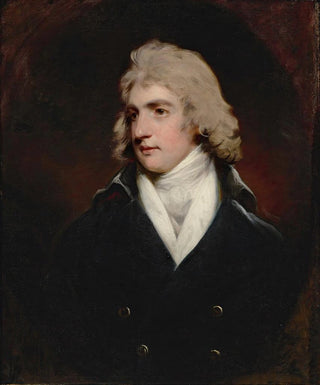Art print | Portrait of Charles Rose Ellis 1771-1845, 1st Baron Seaford - John Hoppner


View from behind

Frame (optional)
In the fascinating world of art, some works transcend time, capturing not only appearance but also the very essence of their subjects. The "Art print of Charles Rose Ellis 1771-1845 1st Baron Seaford" by John Hoppner is a perfect example. This painting, created in the early 19th century, demonstrates the artist's technical mastery and skill in capturing the personality of his models. Through this portrait, Hoppner invites us to explore British aristocracy at a time when social status was closely linked to individual identity. The depiction of Charles Rose Ellis, an influential man of his era, immerses us in a period when portraiture was an essential means of social and political communication.
Style and uniqueness of the work
John Hoppner's style is distinguished by its striking realism and subtle use of light and shadow. In this portrait, every detail, from Charles Rose Ellis's elegant costume to the thoughtful expression on his face, is carefully crafted. Hoppner manages to create an atmosphere of dignity and respectability, while also revealing a certain vulnerability. The rich colors and texture of the clothing, as well as the delicacy of the features, reflect a meticulous attention to detail that characterizes the artist's work. This portrait is not limited to a simple physical representation; it also evokes the values and aspirations of the aristocracy of the time, while providing a glimpse into the social conventions that prevailed at the beginning of the 19th century. In sum, Hoppner's work is a celebration of the individual, rooted in a broader historical context.
The artist and his influence
John Hoppner, born in 1758, is one of the most renowned portraitists of his time. His career was marked by a series of prestigious commissions, allowing him to mingle with the elite of British society. Influenced by the great masters of the past, Hoppner developed a personal style that combines classicism and modernity. His approach to portraiture, characterized by meticulous attention to detail and a deep understanding

Matte finish

View from behind

Frame (optional)
In the fascinating world of art, some works transcend time, capturing not only appearance but also the very essence of their subjects. The "Art print of Charles Rose Ellis 1771-1845 1st Baron Seaford" by John Hoppner is a perfect example. This painting, created in the early 19th century, demonstrates the artist's technical mastery and skill in capturing the personality of his models. Through this portrait, Hoppner invites us to explore British aristocracy at a time when social status was closely linked to individual identity. The depiction of Charles Rose Ellis, an influential man of his era, immerses us in a period when portraiture was an essential means of social and political communication.
Style and uniqueness of the work
John Hoppner's style is distinguished by its striking realism and subtle use of light and shadow. In this portrait, every detail, from Charles Rose Ellis's elegant costume to the thoughtful expression on his face, is carefully crafted. Hoppner manages to create an atmosphere of dignity and respectability, while also revealing a certain vulnerability. The rich colors and texture of the clothing, as well as the delicacy of the features, reflect a meticulous attention to detail that characterizes the artist's work. This portrait is not limited to a simple physical representation; it also evokes the values and aspirations of the aristocracy of the time, while providing a glimpse into the social conventions that prevailed at the beginning of the 19th century. In sum, Hoppner's work is a celebration of the individual, rooted in a broader historical context.
The artist and his influence
John Hoppner, born in 1758, is one of the most renowned portraitists of his time. His career was marked by a series of prestigious commissions, allowing him to mingle with the elite of British society. Influenced by the great masters of the past, Hoppner developed a personal style that combines classicism and modernity. His approach to portraiture, characterized by meticulous attention to detail and a deep understanding






